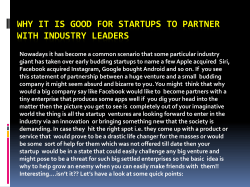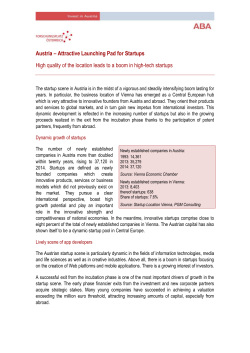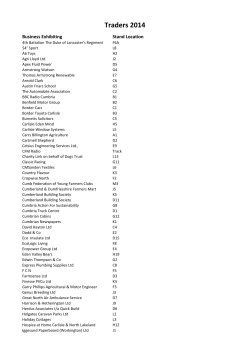
Launcher Guide to Writing a Business Plan & Executive Summary 1 schoolforstartups.co.uk/launcher
Launcher Guide to Writing a Business Plan & Executive Summary © 2013 School for Startups Ltd. All Rights Reserved | schoolforstartups.co.uk/launcher 1 Introduction to Writing a Business Plan & Executive Summary People who want to lend you money or invest in your business in order to earn a percentage of the revenues you generate often ask you to write a business plan. The business plan you give them should allow them to quickly become experts in how to run your business. This is because, in effect, you are asking them to join your business as a financial partner and they need a way to judge the risk you are asking them to take. They need to know: ● ● ● ● ● ● ● ● ● ● ● ● ● What products or services you deliver Who buys what you sell. Who your competition is What advantages your product has over others that will help it sell What financial relationship you have with the customer (rent, lease, sale, subscription, licence) How your products and services are priced relative to your competition Who your strategic partners are What assets you have and what protects them from being stolen What industry trends (positive or negative) may impact your business The background of your staff, core competencies and past experience are. How much money the business has made How much the business will earn if funding is provided. When and how they will be repaid. This document reviews how to write a business plan that provides this information. If you find these questions the least bit difficult to answer, we strongly urge you to attend a School for Startups Bootcamp. We can provide you with the training you need to start a strong successful business, and that includes deciding what kind of business would be easiest to start and most profitable to run. The Structure of Your Business Plan The following outline details a good structure for a startup or early stage business plan. Each of the items in the outline represents a heading in your business plan, and under each one you should write a paragraph that provides the information described in the heading. The Executive Summary, which appears first in your business plan is actually written last. It is a summary of information have put in sections 2 through 11. © 2013 School for Startups Ltd. All Rights Reserved | schoolforstartups.co.uk/launcher 2 1. Executive Summary a. What Our Company Delivers to Our Customers b. When We Launched & How We’ve Done So Far c. How We’re Looking to Expand Operations d. What We Need From Our Funder e. Funding Required i. This section outlines how much funding you need in order to achieve your goals. 1. Layout how much money you have already invested, what assets and resources you’ve acquired, big customers or strategic partners you’ve landed. 2. Lay out how much money you need in order to execute the rest of your plan. 3. In your business plan you should not specify if this funding should come to you as a loan, investment, grant, donation. Do not promise a return on investment or interest. These are terms you would discuss with a funder after they’ve expressed interest. Speak to a lawyer before you solicit investment from strangers and promise them shares or a percentage of revenue earned. f. Our Team (or Our Founder) i. Provide a short paragraph for each team member that details their duties and what qualifies them for the job. Change this section to “Our Founder” if you are the only one in your business. g. Summary i. Provide information on how people who read this business plan can contact you if they are interested in supporting your company 2. Our Product (or Service) a. Write a description of what you deliver to customers. If you have multiple types of customers detail what you deliver to each one. For example, a magazine might say “For readers we deliver...” and “For advertisers we provide...” b. Describe your financial relationship with each type of customer (rent, lease, sale, license, etc) and how much they pay for your product or service. 3. Our Customers a. List the markets you serve and define them clearly. For example: We serve single mothers between the ages of 18 and 34 with children under the age of two in London. 4. Our Marketing Plan a. Review how you make initial contact with these customers, how they make their first purchase, how you maintain contact with them over time, how and why they make additional purchases, how you make it easy for them to refer you to others. b. Provide a link to websites and social media sites. c. Detail the number of people you have in your customer database, in your mailing © 2013 School for Startups Ltd. All Rights Reserved | schoolforstartups.co.uk/launcher 3 list, following you on social media, etc. Document how sales increase when you market to customers via these lists. d. If you’ve received significant mass media coverage you may want to provide links to articles online or printouts of the coverage in an appendix. e. Repeat this process for all market segments you serve. 5. Our Competition a. How We Define Our Competition: Review that your competition serves the same target market you do and define that target market by demographic, location, and/or other relevant parameters. Example: The competition for Flywheel Bespoke Blue Jeans serves Women in the UK between 13 and 35 who more than one hundred pounds on a pair of trousers and who like to shop in high end stores. b. Table of Competing Companies & the Products & Services They Sell. Limit this list to the top 10 companies you compete most directly with your for your target market’s dollar. i. List each company by name, provide their website address, ii. list the products/services they sell which compete with your product or service. iii. Document what each company promises customers. iv. List the advantages they offer customers as a business. v. List the advantages their products or services offer customers. vi. List their pricing. vii. For each company and product or service listed, document the advantages your company has. viii. Note that the purpose of this exercise is simply to bring your potential funder up to speed on the competition, to demonstrate you know who your competitors are and know how you and your products stack up against them. c. Summary of Our Advantages d. Steps We’ll Take to Increase Our Competitive Advantage & Our Profits Profit: Document how you will use funding you receive to more competitive and thus able to increase your revenue, lower your costs, expand the number of people you reach, etc. 6. Our Industry a. Provide an overview of Government, Social and Technical Trends that are impacting your company and your competitors. For example, your organic bakery may be subject to new laws about the ingredients that go into products labeled “organic”. The public may be more aggressively seeking out organic food, and may even be buying it online. b. Detail how your business is changing to use these trends to your competitive advantage. For example, you may detail how you’ve changed your recipes and had your food certified by government inspectors, and how you’ve launched a website to help customers buy your products online. 7. Our Assets © 2013 School for Startups Ltd. All Rights Reserved | schoolforstartups.co.uk/launcher 4 a. Provide an overview of your assets. Remember this doesn’t include you, your cofounders, or any skills you have. It may include: i. Customer and supplier contact databases you’ve developed over time that you leverage to sell more and spend less than competitors. ii. Copyrights, patents, registered designs, trade secrets, etc that protect you from competition, iii. Property you own or lease that helps you find customers or run your business more cost effectively. 8. Our Founder(s), Staff & Strategic Relationships a. Detail when the business was founded, who started it, and why. This should be couched in the customers needs, not in terms of the needs of the founders. Example: We started making our aprons as a hobby, but sales took off and we built a business around them. People love our aprons because they come in every size, they are brightly colored, stain resistant and durable. b. List what each of the founders does for the company from day to day. Document the specific background and expertise they bring to the company and their duties. c. List key employees you have hired to work with you. Detail their title, what they do for the company, how long they have been with you. Identify their relevant background and special expertise. d. List strategic relationships you’ve established i. Visibility partners who promote your brand as part of their marketing, sales or support operations. ii. Activity partners who share tradeshow and other expenses. iii. Suppliers who favor you with very deep discounts in return for bulk sales. 9. Our Strengths, Weaknesses, Opportunities & Threats a. Based on what you’ve written previously, document five to ten specific strengths your business, your products & your company have that make you very likely to thrive in the months and years ahead. b. Document three to five weaknesses that your company must address in order to do well. Generally you should document things that your funder’s investment will allow you to change. You should be taking their investment in order to reduce your weaknesses. c. Document five to ten specific opportunities you can take advantage of in order to increase your sales or dramatically reduce your costs in the months and years ahead. Generally you should document opportunities your funder’s investment will allow you to take advantage of. d. Document three to five threats that your company must be aware of and address in order to stay in business and profitable. Generally you should document opportunities your funder’s investment will allow you to address. They may be things like high credit line debt that, if not paid off due to a sudden change in the economic climate, will force you to go bankrupt. They may also be things like too much dependence on a single source material supplier or a single employee. 10. Our Financials © 2013 School for Startups Ltd. All Rights Reserved | schoolforstartups.co.uk/launcher 5 a. You can find templates for these documents online using Google. If you are a brand new startup you may only have to provide the cash flow. i. Current Income Statement ii. Current Balance Sheet iii. Cash flow showing monthly income and costs for the next 12 to 24 months. after you get the funding you’re asking for. 11. Our Financial Forecasts Based on Receipt of Funding a. Provide three financial forecasts that show worst case, best case and most likely annual profits over 3 to 5 years based on your receipt of the desired funding. You’re helping people reading the plan understand how much profit there will be if things go as expected, go very badly or go very well. b. Document your assumptions. Every financial forecast is based on a set of conditions that are expected to remain the same or change in expected ways. Documenting these expectations helps investors decide whether or not your forecasts take into account all the risks they see and all the expectations they have. i. How money will be received by the company (grant, loan, sale of shares, etc) ii. How money will be repaid if required. iii. Increased profits due to investment iv. How investors will be compensated v. etc. 12. Appendices a. Provide any documents investors really need to see to support statements you’ve made in your business plan. Terse, Clear, Easy to Understand In writing your business plan there are several things to keep in mind: ● ● ● ● ● ● Most people who choose to fund startups have started businesses of their own. So keep things straightforward, simple, nonflowery. Pretend, as you write it, that you are talking to a person you are going to hire and you’re quickly explaining your business to them. Communicate, clearly, what you do that people need or want, who you do it for, how much money you’ve made doing it, and how you know your business will continue to become more profitable in the months and years to come. Use images and tables that sum up important aspects of your business when possible. Make sure the the images are useful, clear and meaningful. Use bullet points and colored text boxes to highlight important points. Long blocks of text are hard for investors to read. Make tables and spreadsheets simple, short and easy to read. Before anyone invests in, lends or grants your business they will talk to you and will thus have an opportunity to ask you questions about things they don’t understand. Thus your © 2013 School for Startups Ltd. All Rights Reserved | schoolforstartups.co.uk/launcher 6 ● ● ● ● job is not to answer every possible question they might have in your business plan. Your job is, instead, to provide potential funders with a business plan that clearly communicates why your business is worth talking about. A pretty, well written, business plan gets far more attention than a less attractive one. Potential funders see lots of business plans and many are very hard to read and most are very plain if not downright ugly. A concise, clear, attractive, easy to read document that conveys what investors want to know about a good business swiftly garners attention. Furthermore it indicates that you have the time, money, expertise and insight required to create a great document. The best possible preparation for writing a business plan is to read a few dozen. You can find thousands of business plans online and if you ask friends who have businesses you’ll find they are usually happy to show them to you. Pay particularly attention to business plans that have received funding. You’ll be able to see what makes them stand out. As you work on your business plan you’ll probably discover your business that has issues that need to be addressed in order to be attractive to potential funders. You may have to pay down debt, increase sales, spend time getting designs registered, etc. Don’t let that get you down. That’s a normal side effect of writing a business plan. It forces you to take stock of your enterprise. A great business plan for a great company will gain support from all kinds of people. Make both the business and the plan good. Rules Regarding Accepting Investment & Loans from Individuals You can’t just show your business plan to anyone and accept a loan or an investment based upon it. How you solicit investment, how you sell shares, how you accept and repay loans, what disclosures you have to make, and how you have to handle funders if your business goes out of business are all governed by strictly enforced laws. Consult with legal professionals who specialize in startup funding prior to providing people with your business plan. They can review what other documents you may need to provide to potential funders along with your business plan, and can discuss who may and may not invest money in a small business. © 2013 School for Startups Ltd. All Rights Reserved | schoolforstartups.co.uk/launcher 7
© Copyright 2025





















